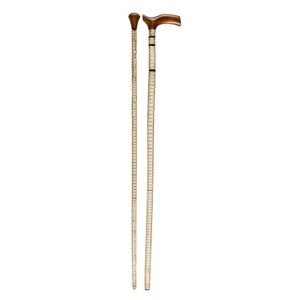Canes
From around 1550 to 1930, canes were a dressing accessory without which a lady or gentleman, properly dressed, would never leave the house. However their use went out of fashion after this, leaving the market to collectors.
For a collector, the main interest lies in the handle, which could be made of wood, bamboo, ebony, ivory, tusk, animal horn, or bone. Sometimes they were made out of porcelain, Bakelite, gold, silver, or glass; enameled or cloisonnéd; or sprinkled with precious gemstones. The height of good taste was a gold handle with minmal decoration, as silver handles were despised by
more...
the wealthier classes. However silver handled canes have survived in large numbers, and exhibit a wide variety of decorative treatment, from the comparatively plain, armorial or regimental style to the more flamboyant excesses of Art Nouveau.
Carved handles can be found depicting grotesque animal or human forms, and are highly prized nowadays. Also keenly sought are multi-purpose canes, with a concealed spirit flask, tobacco pipe or even a tiny fire-arm for personal safety.
less...
A walking stick was an integral part of every well dressed man's wardrobe in the nineteenth century, and his collection of walking-sticks were probably kept just inside the hall in a stand, sharing space with umbrellas.
Walking-sticks and canes derive from the cudgels and staves carried for defence, evolving into dress accessories topped with silver or ivory, with a ferrule at the point to cut down wear. Many had elaborately carved heads. Sometimes these unscrewed to reveal space for a snuff box or other article. About 200 ancillary accessories are known to have been incorporated into walking
more...
sticks, the best known being the sword. Sword sticks date back to the sixteenth century, and often the sword just slides out with the stick acting as a sheath. Other sword and knife designs had a spring mechanism and would release on the press of a button or lever.
Other sticks pull apart, revealing a dagger with a handle for the left hand, and a stick with a blade for the right hand. Two steel blades sliding into the shaft from each end probably represent duelling weapons. The poacher's gun was a simple weapon in the shape of a walking stick; more sophisticated was a six-barrelled revolver, exposed by pressure on a trigger-spring that expelled part of the cane, and which had a dagger in the centre of the barrels.
Most extravagant was the machine-gun in a rectangular cane. "The kit", as it was 'known, was a pocket violin; this was developed into a violin fitted into a cane with a two-inch (5cm) diameter. Other canes contained music-boxes, harmonicas, flutes, piccolos, pipes (including opium pipes), vesta boxes, cigarette holders, candles, battery torches (dating from as early as 1882), contraceptives, poison, and a whole tribe of canes known as working companions (scalpels for doctors, small spades for botanists, safety lamps for miners). Among the most curious is the voyeur's cane with a mirror above the ferrule enabling the user to look up women's skirts.
less...










 Loading more...
Loading more...